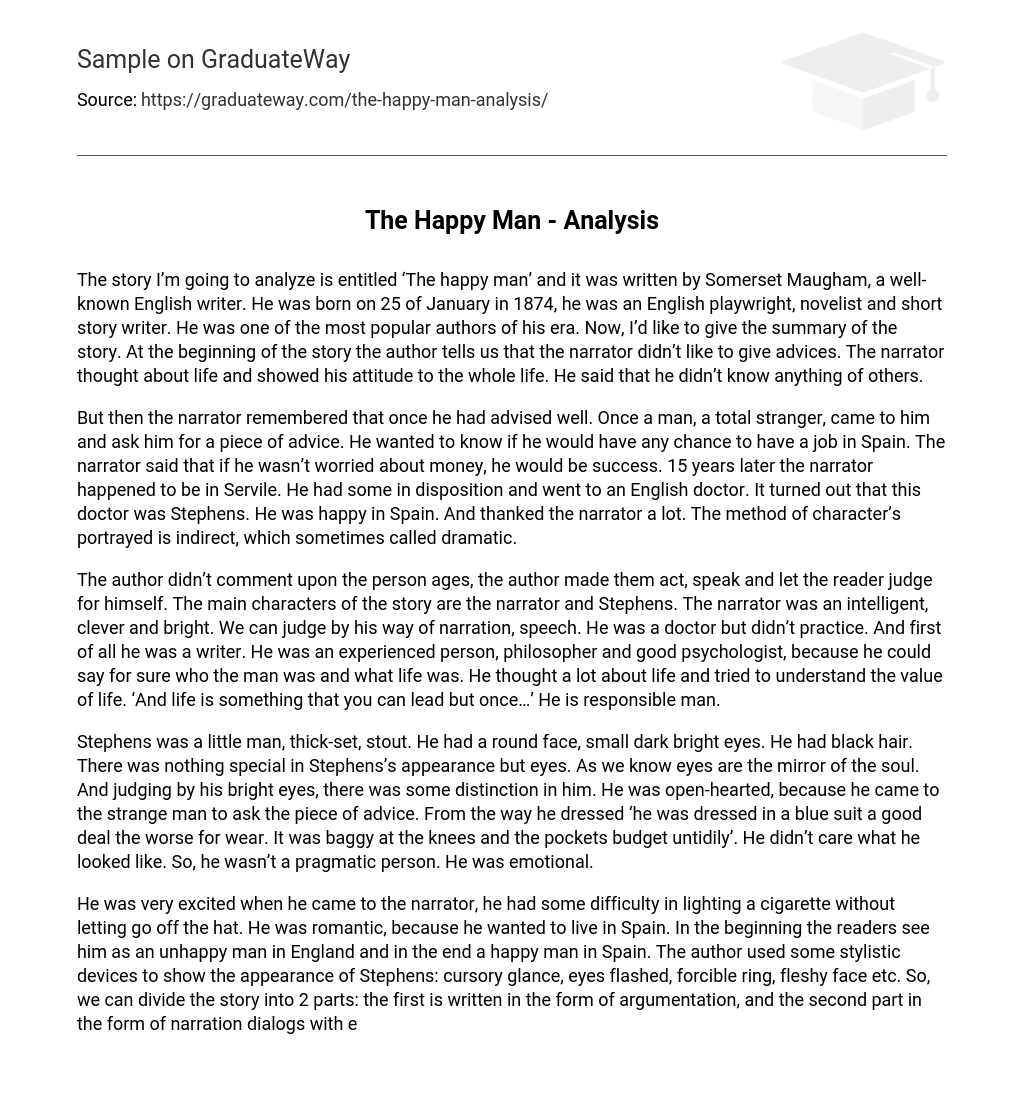The story I’m going to analyze is entitled ‘The happy man’ and it was written by Somerset Maugham, a well-known English writer. He was born on 25 of January in 1874, he was an English playwright, novelist and short story writer. He was one of the most popular authors of his era. Now, I’d like to give the summary of the story. At the beginning of the story the author tells us that the narrator didn’t like to give advices. The narrator thought about life and showed his attitude to the whole life. He said that he didn’t know anything of others.
But then the narrator remembered that once he had advised well. Once a man, a total stranger, came to him and ask him for a piece of advice. He wanted to know if he would have any chance to have a job in Spain. The narrator said that if he wasn’t worried about money, he would be success. 15 years later the narrator happened to be in Servile. He had some in disposition and went to an English doctor. It turned out that this doctor was Stephens. He was happy in Spain. And thanked the narrator a lot. The method of character’s portrayed is indirect, which sometimes called dramatic.
The author didn’t comment upon the person ages, the author made them act, speak and let the reader judge for himself. The main characters of the story are the narrator and Stephens. The narrator was an intelligent, clever and bright. We can judge by his way of narration, speech. He was a doctor but didn’t practice. And first of all he was a writer. He was an experienced person, philosopher and good psychologist, because he could say for sure who the man was and what life was. He thought a lot about life and tried to understand the value of life. ‘And life is something that you can lead but once…’ He is responsible man.
Stephens was a little man, thick-set, stout. He had a round face, small dark bright eyes. He had black hair. There was nothing special in Stephens’s appearance but eyes. As we know eyes are the mirror of the soul. And judging by his bright eyes, there was some distinction in him. He was open-hearted, because he came to the strange man to ask the piece of advice. From the way he dressed ‘he was dressed in a blue suit a good deal the worse for wear. It was baggy at the knees and the pockets budget untidily’. He didn’t care what he looked like. So, he wasn’t a pragmatic person. He was emotional.
He was very excited when he came to the narrator, he had some difficulty in lighting a cigarette without letting go off the hat. He was romantic, because he wanted to live in Spain. In the beginning the readers see him as an unhappy man in England and in the end a happy man in Spain. The author used some stylistic devices to show the appearance of Stephens: cursory glance, eyes flashed, forcible ring, fleshy face etc. So, we can divide the story into 2 parts: the first is written in the form of argumentation, and the second part in the form of narration dialogs with elements of description.
The style of the author is clear. Maugham wrote from the first person, it is made the reader believe that this is a real story, and it is made the narration closer to the reader and more intimate. The style is a mixture of neutral and literary layer (poetic words: dark cloak of Destiny, paint the finger of fate). The style is full of stylistic devices. It helps the readers to get the main idea and interested what images are represented. So the author used such stylistic devices as metaphor: ‘a prisoner in solitary tower’, ‘dark cloak of Destiny’ etc.
The narrator shows the readers his attitude towards life, thinks about the value of life. Hyperbole ‘I wouldn’t exchange the life. I’ve had with that of any king in the world’ is used to show that Stephens was very happy and wasn’t concerned about material things. So, also in the story there is an inversion and repetition ‘Poor I have been and poor I always be’. Parallel syntactical constructions such as: ‘’I was, I never, I’ve never done…’, ‘there is sunshine, there is good wine…’ underline the importance of what Stephens told. The sentences in the story are rather simple and complete, the paragraphs are balanced.
Also, there are rhetorical questions with the help of them the author tries to understand what the value of life are. There are a lot of antithesis: ‘Stephens’s salary was pretty good, but his clothes where shabby’, in the beginning he was an unhappy man and in the end he was a happy one, Spain – is full of emotions, freedom, romantic, and England is conservative. Allusions: Carmen – a symbol of Spain, of freedom etc. The central idea is not stated directly in the text. Happiness is something that you can achieve only by yourself. And Stephens proved it.





